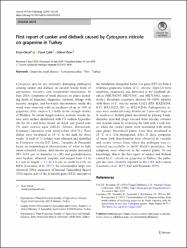| dc.description.abstract | Cytospora species are seriously damaging pathogens causing canker and dieback on several woody hosts of agronomic, forestry, and ornamental importance. In June 2018, symptoms of trunk diseases on plants including death of branches, diagnostic chlorotic foliage with necrotic margins, and brownish discoloration inside the wood were observed with an incidence of up to 10% in grapevine (Vitis vinifera L.) fields in the Arapgir district of Malatya. To obtain fungal isolates, necrotic woody tissues were surface disinfected with 1% sodium hypochlorite for 60 s and twice rinsed, air dried, and placed onto 2% malt extract agar (MEA) (Merck, Darmstadt, Germany) amended with tetracycline (0.01%). Petri dishes were incubated at 25 °C in the dark for three weeks. A total of 14 isolates were obtained and identified as Cytospora viticola D.P. Lawr., Travadon & Pouzoulet based on morphological characteristics of white to light straw-coloured colony, dark-brown pycnidia measured 947–1618 μm in diameter (n = 20) and pycnidiospores were hyaline, allantoid, aseptate, and ranged from 4.2 to 6.1 μm in length × 1.1 to 1.8 μm in width (n = 50) on MEA (Lawrence et al. 2017). No teleomorphic stage was observed. DNA sequences of Internal Transcribed Spacer (ITS) region, part of the β-tubulin gene (BT2), and part of the translation elongation factor 1-α gene (EF1-α) from a reference grapevine isolate of C. viticola (Arp2-D) were amplified, sequenced, and deposited in the GenBank database (MK706295, MK715441, and MK715442, respectively). Resultant sequences showed 99–100% identity with those of C. viticola isolate Cyt21 (ITS: KX256244, BT2: KX256223, EF1-α: KX256265). Pathogenicity assays were conducted using disinfected 2-year-old twigs of V. vinifera cv. Köhnü plants inoculated by placing 5-mm-diameter mycelial plugs excised from ten-day colonies into wounds made by removing the bark with a cork borer, while the control plants were inoculated with sterile agar plugs. Inoculated plants were then incubated at 25 °C in a 12-h photoperiod. After 21 days, symptoms of inner bark discoloration were observed in vascular and cortex tissues from which the pathogen was re-isolated successfully to fulfill Koch’s postulates. No symptoms were observed in the control plants. To our knowledge, this is the first report of canker and dieback caused by C. viticola on grapevine in Turkey; the pathogen has been currently reported in the USA and Canada (Lawrence et al. 2017; Farr and Rossman 2019). | en_US |


















